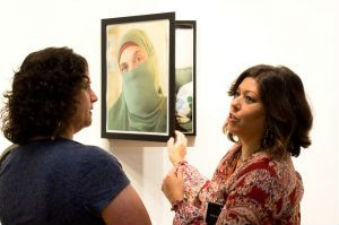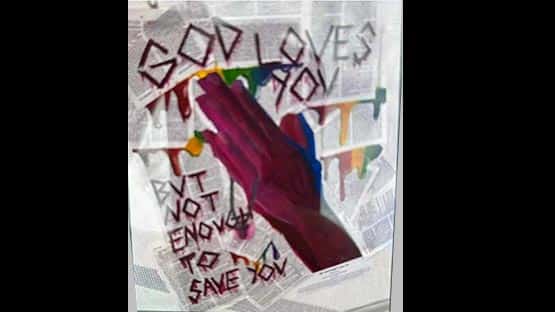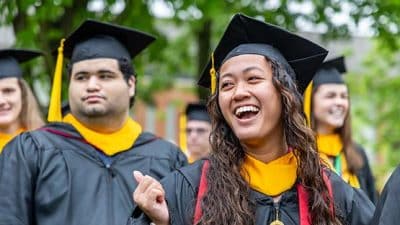Nourah Alhasawi invites viewers to confront their preconceived notions about face-veiled Muslim women. Not as an American, or a Christian, or a member of any demographic – but as one person to another.

Alhasawi is a professor of Islamic Studies at Princess Nourah University in her home country of Saudi Arabia. She also wears a face veil.
For her capstone project to earn a master’s degree in conflict transformation at Eastern Mennonite University’s Center for Justice and Peacebuilding, Alhasawi gathered 20 women and interviewed them on their feelings about face veils. Then, each participant was photographed in various stages of the veiling process – unveiled, partially covering the hair, fully covering the hair, wearing a colorful face veil, and wearing a plain black face veil. Each participant was again interviewed about their experience, and some met for group discussion.
The Margaret Martin Gehman Art Gallery was filled to capacity for Alhasawi’s presentation.
“These women are not terrorists … they are not even Muslim,” she told the crowd.
For the presentation, Alhasawi hung twenty hinged portraits in the gallery – the viewer first encountered a fully veiled woman, eyes appearing somber or powerful, a few mischievous – then “opened” the portrait to reveal the subject with only partially covered hair.
In America, Alhasawi says, “The more visible my face-veil is, the more invisible I become.” In light of the invisibility, harassment and oppression she endured as a face-veiled Muslim woman in America, she created this project with the hope that viewers would set down their cultural baggage and encounter the portrait subjects as individuals.
“It’s not about systems, it’s not about ideology, it’s about you and me,” says Alhasawi. She explained the various “problematic responses to difference” that people exhibit: acting as if the “other” has no personhood, demonizing and dominating the “other,” and portraying the “other” as exotic and therefore not dignified. Alhasawi also pointed out a problematic response that can stem from a desire for equality: minimizing the other’s differences.
“If you don’t see my difference, then you don’t see me. Or you don’t see me fully,” says Alhasawi. She pointed out that unveiled faces are not a universal norm: she had to become accustomed to seeing American clothing (and lack thereof).
Alhasawi also explained the danger of moral overcorrection: according to a Pew Research Center study, only 12 countries in the world legally require some form of religious garb for women, while 39 countries legally prohibit some form of the same. “They have this assumption that women would only wear this by force, so they force them not to wear it.”
“Nourah is a social entrepreneur, willing to take risks and cross her comfort zones,” says Professor Carl Stauffer, her practicum and academic advisor. She also enlisted the help of Howard Zehr, Soula Pefkaros, and Adriana Hammond to photograph the subjects of this social experiment.
“We overcame so many things in less than an hour,” says Alhasawi. One participant first described women in black face veils as “scary,” but closed their last interview by presenting Alhasawi with a gift of a black scarf.
“It made me think much more about myself than it did face-veiled Muslim women,” says participant Frances Flannery, director of the Center for the Interdisciplinary Study of Terrorism and Peace at James Madison University. The project made Flannery reflect on society’s “claims” on women – such as how they should appear and express themselves – characteristics which are covered by a face veil.
Alhasawi hopes there will be other opportunities to display the photographs in the United States, and intends to write further about the project’s implications. She has returned to Saudi Arabia to teach two graduate classes and continue research projects on women’s rights and English-language representations of the prophet of Islam.










